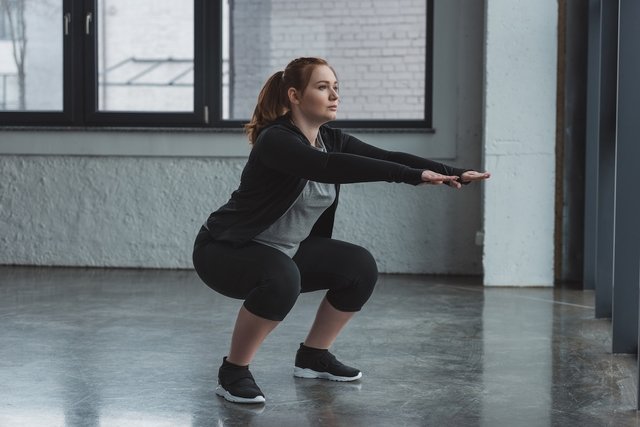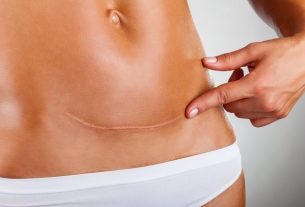To increase your butt, it is recommended that you perform exercises that work the gluteal muscle, such as squats, lunges and hip raises, for example, as they promote local contraction and promote muscle mass gain.
However, it is important to keep in mind that it is not a quick process, and it is important that the exercises are carried out regularly, under the guidance of a physical education professional, and that the person also has a healthy diet rich in proteins.
Other options for increasing the butt are aesthetic treatments, such as electrical stimulation and lipocavitation, for example, as well as fat grafting and silicone implants in the buttocks. Among these options, the only one that guarantees a quick result is the silicone implant, however it is also associated with a higher cost.

Some options to increase your butt are:
1. Exercises
The best exercises to promote gluteal enlargement are those that work the gluteus maximus, medius and minimus muscles, and the muscles on the back of the thigh, some of which are:
- Squat, in which the person must open their legs hip-width apart and squat, as if they were going to sit on a bench, keeping their back straight and avoiding compensating with their hips. The squat can be performed with just your own body weight, using a dumbbell or bar resting on your back or shoulders, and is called a front squat. In addition, you can also do sumo squats, in which your legs should be wider and your feet turned outwards;
- Hip raise, in which the person must lie on the floor, with their knees bent, and raise their hips, keeping their feet, head and upper back well supported on the floor. When lifting your hips, it is important to contract your glutes to promote muscular work. Another way to perform this exercise is using a dumbbell or a bar, with the person resting their upper back on a bench and raising their hips;
- Lunge, in which you must take a step forward and flex your knee until the thigh of the front leg is parallel to the floor. To make the exercise more intense, you can place one of your feet on the step, which can be positioned in front or behind the body, or place the foot behind on a bench, this exercise being called the Bulgarian lunge;
- Flexor lying downin which the person must lie down on the equipment, positioning their feet under the support, and then make the movement of placing their feet on their buttocks;
- Stiffin which with a bar in front of the body or two dumbbells, the person must hold the load in front of the body and make the movement of touching it to the floor, but keeping the back aligned and knees semi-flexed, at the same time as pushing the hips back a little when descending;
- Deadlift, in which the person must have their knees slightly bent, as if they were going to do a squat, lift the load to hip height and then place it back on the floor. It is important to keep your back, hips and shoulders aligned to avoid injuries.
These exercises can help in the process of increasing and defining the glutes when they are performed correctly according to the guidance of a physical education professional. The way these exercises are performed may vary according to the person’s physical fitness, and the instructor may propose the performance of more or fewer repetitions and variations of the applied method and exercise.
Furthermore, to guarantee the results of your training, it is very important to have a balanced and healthy diet, in which there is a greater consumption of proteins, as this will help you to gain muscle mass.
Is the result definitive? Not exactly, because when you stop training your muscles regress in size, returning to their original size. But with regular physical activity and intensified gluteal exercises, they can remain at their expected size or increase in size.
2. Treatments with aesthetic devices
Aesthetic treatments can help increase volume and stimulate local fat burning, such as:
- FES and Russian current, which are electrical stimulation devices that recruit a greater number of muscle fibers during use;
- Lipocavitation, which helps eliminate localized fat;
- Radio frequency, which helps combat sagging.
These treatments must be carried out by a dermatologist, dermatofunctional physiotherapist or specialized beautician, and 3 to 6 sessions may be necessary depending on the type of procedure.
Is the result definitive? Not exactly. For the results to be maintained, the person must not gain weight or stop practicing physical activity. If this happens, all results achieved with aesthetic devices will be lost.
3. Lipografting on the butt
Plastic surgery on the butt can be performed with a fat graft, taken from the belly or flanks. To perform fat grafting, the plastic surgeon performs liposuction, removing localized fat from another region of the body, which is properly treated and then grafted onto the buttocks.
Recovery takes a few days, and it is necessary to rest, avoid exertion and perform lymphatic drainage sessions to remove excess fluid and facilitate recovery. See more details about fat grafting.
Is the result definitive? Yes. Although after a few months there is a small reduction in the buttocks after fat grafting, the results remain very close to what is expected.
4. Silicone butt implant
Placing a silicone prosthesis in the buttocks is also a quick option for enlarging the buttocks, and the results can be seen in approximately 1 month, after recovery from surgery and reduction of local swelling. As with any other surgery, this can also have health risks, so there are contraindications that must be respected.
To perform this type of aesthetic surgery, the doctor can make two small incisions in the region closest to the end of the spine and insert the previously chosen prostheses, immediately observing the new appearance of the buttocks. After that, the incision is closed and if everything is under control, the person can go to their room the same day. The hospital stay is approximately 2 days but full recovery occurs after 6 months, when there should be no changes in the buttocks.
Is the result definitive? Yes. The silicone prosthesis has the most definitive result, because the prosthesis does not change size and is not related to external factors, however, this type of treatment requires a greater financial investment.





